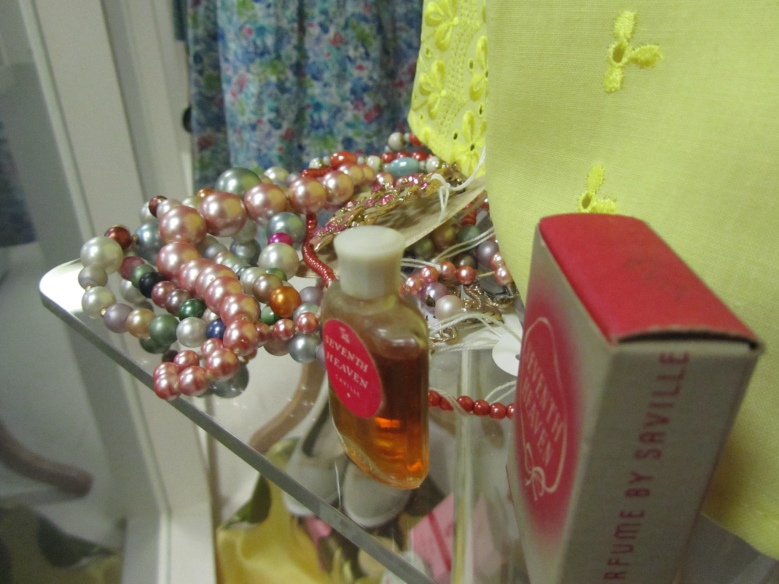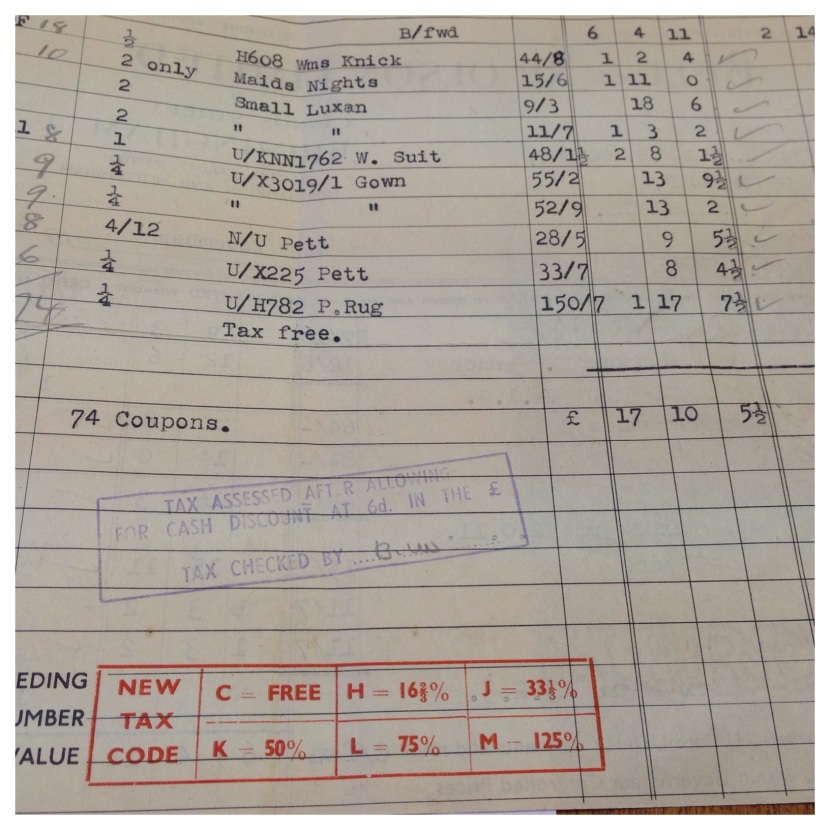Tagged: 1940s
Exhibition: Austerity to Prosperity
I was honoured and excited when Walsall Museum invited me to take part in planning this exhibition. My brief was to select items from the Hodson Shop Collection that told the story of the transition from wartime austerity to the relative prosperity of the 1950s. The clothing in the collection fits perfectly within this tumultuous period and provides evidence of what Black Country women were wearing during the post-war period. There are the simple yet subduedly elegant utility (CC41) dresses that fade away as the 1950s get into full swing, with full skirts and vivid prints taking over.
My main aim was not to oversimplify the narrative of change; the myth that everyone woke up on 1st January 1950 to find that the drab wartime world had been replaced by a new consumer-driven technicolor dream world. The 1940s may have been a time of austerity but there was still colour, beauty and a booming demand for little luxuries such as lipstick and face powder. Conversely, the 1950s remained austere for many, with food rationing only coming to an end in 1954 (clothing rationing ended in 1949). I reflected this by choosing a few unusual items: a ‘Wartime emergency pack’ of face powder, a surprisingly frilly utility dress, a distinctly dreary wool jersey dress from the 1950s next to a full-skirted confection of a dress from the same time.
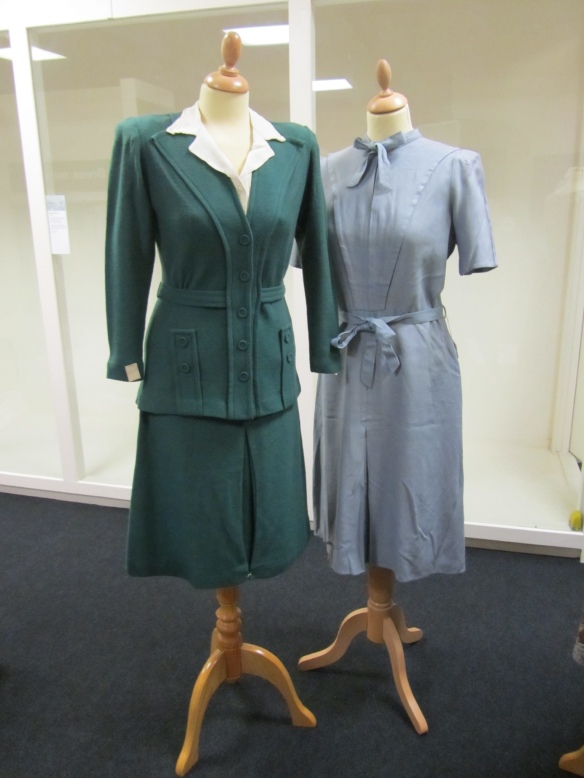
Utility items from the Hodson Shop Collection – creases have been kept in the dress as that is how it was discovered in the Hodson Shop.
Installing the exhibition was great fun and an excellent learning opportunity. I’m really proud of the end result, especially the bit that includes a 1950s twin-tub washing machine!
The clothing accompanies a display of items manufactured or used in the Black Country during the period 1940-1960, again reflecting the aesthetic and ideals of the shift from austerity to prosperity. The exhibition is part of the region-wide Black Country Echoes festival and runs 3 Sept-10 Jan 2015. Admission is free.
Thanks to the team at Walsall Museum for providing me with this opportunity and supporting me along the way!
From Austerity to Prosperity
3 Sept 2014-10 Jan 2015
Community History Gallery, Walsall Museum, Lichfield Street, Walsall.
Audio: Purity, Piety and Pants – The Religious Body in Early-20th Century Underwear Marketing
I’m thrilled to be able to share this audio file of my recent conference paper with you.
This recording is by no means the finished article but I have noticed that the subject really captures people’s attention so it felt right to share it. There is a lot more work and research to be done on the subject – especially concerning anxieties around the adulteration and cleanliness of fabrics.
In the meantime, I hope that you enjoy listening and I welcome any thoughts or ideas in the comments below.
Thanks to the wonderful Katrina Maitland-Brown for making this recording and to everyone at CHORD for the opportunity to speak at their workshop. As always, massive thanks to the team at Walsall Museum for their ongoing support.
References:
C. Willett and Phillis Cunnington, The History of Underclothes, (London: Faber, 1981).
Keith Jopp, Corah of Leicester 1815-1965, (privately printed, 1965). (read the PDF here)
C.W Webb, An Historical Record of N.Corah & Sons Ltd., (privately printed, 1947). (read the PDF here)
Elizabeth Ewing, Everyday Dress 1650-1900, (London: B.T Batsford Ltd., 1989).
Also see the ‘About’ section of the Wolsey website for their take on the brand’s history.
Picture Post: Into the Archive…
Back in November 2013 I posted a selection of colourful and charming images from the Hodson Shop archive. Fast forward to today and I’m still working my way through the archive, though the images I’ll be sharing in this post are far less colourful and, perhaps, not quite so visually striking. Yet that’s not to say that the images are without interest or intrigue…
The archive contains invoices and paperwork as well as the catalogues and other ephemera. I have spent the past few weeks working my way through piles of invoices and delivery notes, searching for any links between the items listed and the objects that I have been analysing within the collection.
The aim of the process has been to build as full a biography as possible for the items. The invoices have the potential to answer a lot of questions. Where did an item come from? Who supplied them? How much did they cost? And when did they arrive? These answers can help to trace the life story of the items before their life in the Hodson Shop and Walsall Museum.
It hasn’t been easy. The invoices rarely give much in the way of descriptive detail – information regarding size or colour is a rarity and brand names tend to only crop up for specific items like corsets, hosiery and toiletries. There have been times when I have cursed the 1920s sales clerks for having such sloppy handwriting and not bothering to tell me the colour of a ‘frock’ ordered in 1923! Yet I have found some fascinating matches.
This non-descript brown paper parcel believed to contain children’s cashmere hose is likely to be the “5914 ¾ Hose” item listed on a N. Corah invoice from 2nd February 1923:
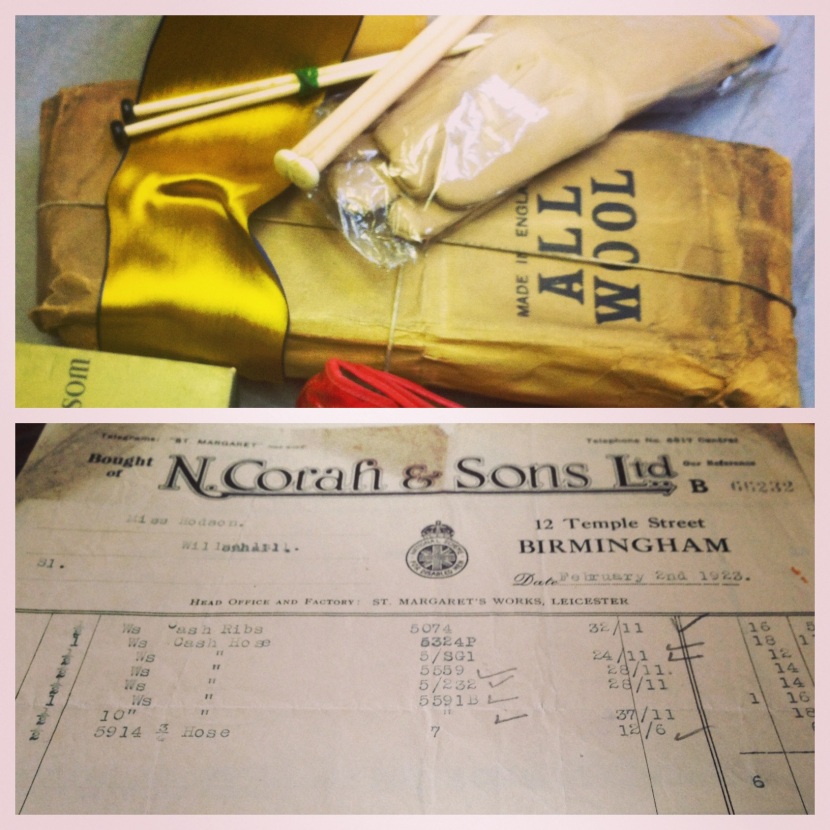
(Top) A parcel containing children’s cashmere hose (Bottom) An invoice from N. Corah & Sons Ltd., 1923 detailing the same hose.
These green ‘mock wing’ feathers? They are listed as ‘Wings’ on this S.C. Larkins & Sons invoice from 18th August 1921:
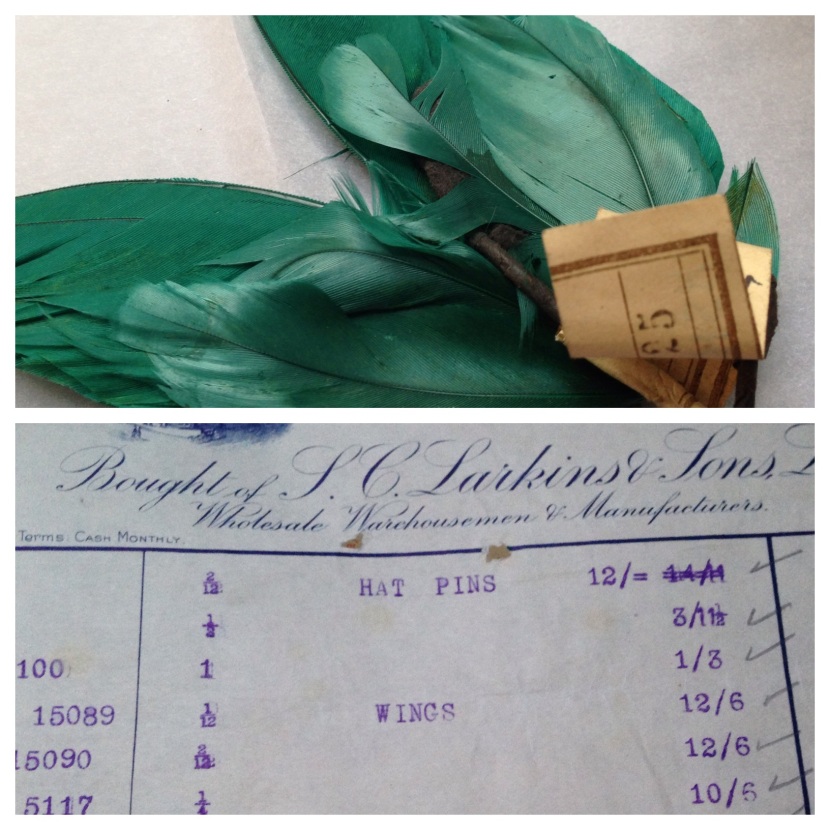
(Top) Jade green mock wings (Bottom) Invoice from S.C. Larkins & Sons Ltd., 1921 listing the same product.
In both of these cases, I’ve been fortunate enough to have item codes to match up. Utility items have been slightly easier to trace, as have some items with the St. Margaret brand due to N. Corah and Sons being both manufacturers and their own wholesaler.
There have been some amusing moments – such as the terribly polite letter from a wholesaler informing Edith Hodson that she wasn’t entitled to the discount she had applied to an order. There’s also the repeated insistence of wholesalers to address Edith and Flora as ‘Sirs’ or ‘Mr Hodson’. Whilst comical to a point, I believe that this error serves to highlight quite how extraordinary Edith and Flora were, operating a business in what was very much a man’s world. They were bold and would often correct such errors. They weren’t afraid to push their luck if it meant saving money:

Letter dated 14th May 1930 from the ‘Counting House’ of N. Corah & Sons Ltd. Note the use of the greeting ‘Dear Sir’.
Something that has struck me is how much stock was coming into the shop. Invoices from some of their major suppliers are often at weekly or two weekly intervals. I need to look into it further but my initial view is that they regularly over-bought, which provides an explanation as to why the Hodson Shop Collection is so large. Another observation is that the sisters tended to only go to the trouble of returning items if they were from local suppliers, such as Walsall-based Ennals & Co. Ltd.. There are far more credit notes from this supplier than others. Maybe travelling to wholesalers further afield was too time consuming and too expensive? Or maybe their goods simply weren’t up to Edith and Flora’s standards?
The invoices themselves are visually interesting. Some feature images of the wholesalers premises, such as S.C. Larkins & Sons Ltd. of Livery Street, Birmingham:
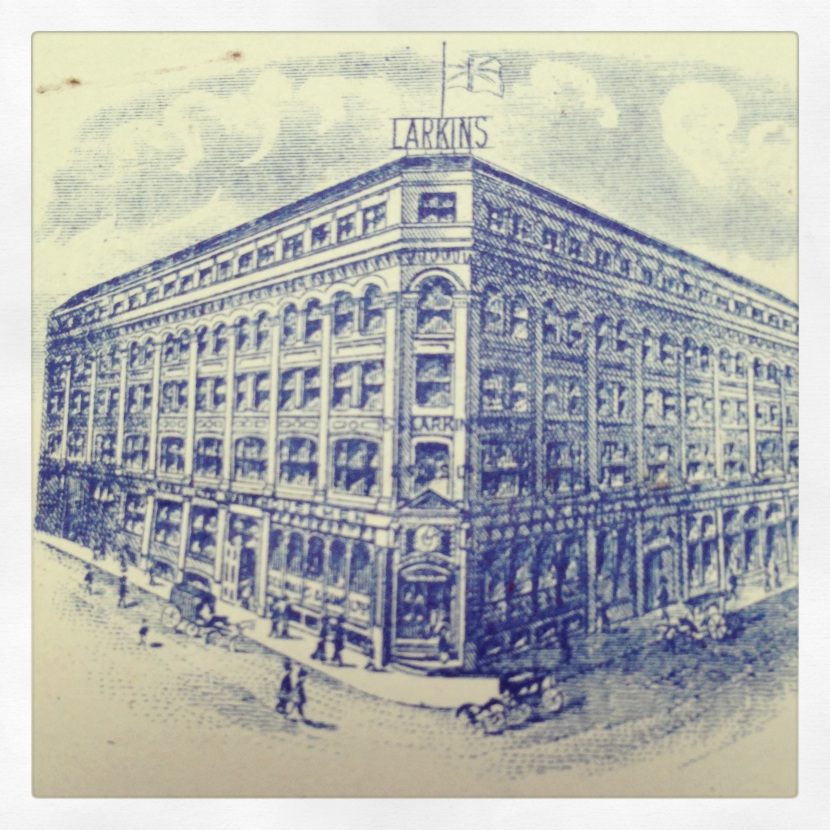
S.C Larkins & Sons wholesalers. Premises on the junction of Livery Street and Barwick Street, Birmingham. Image from 1920 invoice.
There are still hundreds of pieces of paperwork for me to look through and I’m hugely looking forward to being able to cross reference my invoice findings with some of the links I’ve already made between certain items and trade catalogues. It has also been a thrill to see aspects of Edith and Flora Hodson’s personalities show through something as generic and functional as invoices.
Many thanks to Walsall Museum for providing me with access to the archive and for allowing me to photograph the items.
If you wish to explore the Hodson Shop Collection and Archive, please contact Walsall Museum.
Tel: 01922 653116
Email: museum@walsall.gov.uk.
Picture Post: Exploring the Hodson Shop Archives
After a busy few weeks (more on which in a future post), it has been a pleasure to finally get back to hands-on archival research. I’ve spent a few days digging through the Hodson Shop archive of trade catalogues, seeking out links to any of the items I have encountered during my object analysis. Plenty have emerged as I’ve worked my way through piles of trade brochures for Birmingham wholesalers such as Wilkinson and Riddell, S.C Larkin and Sons and Bell and Nicholson. The images below are of some of the things that have caught my eye. They aren’t always hugely relevant to my research but they are the things that have raised some intrigue, a smile or a giggle.
I’ve attempted to give as much detail as possible for each image, though I forgot to note the date and wholesaler for this Christmas apron image. I think it is late-1940s/early-1950s Bell and Nicholson, though I’ll double check when I am next at the museum and update the caption accordingly.
I’ve posted before about underwear and how the collection highlights changing attitudes and approaches to undergarments from 1920s-1960s. The 1920s Queen of Scots promotional material is a prime example of this: hygiene and comfort, alongside endorsement from a pious historical figure (c.f. Cardinal Wolsey and his stockings). This is something that I really want to do some more research into (proposed paper title: Piety, Purity and Pants). If you know of any existing work on early-20th century underwear marketing, please let me know!
The 1930s Wilkinson and Riddell catalogue covers are especially stunning – with their Japanese influences and bold artwork. There is something rather charming about their Greyhound logo, especially when placed next to a bonsai tree. The pink and yellow gladioli cover is a personal favourite.
The S.C. Larkin and Sons brochure, New Designs for 1930. Maids’ and Nurses’ Caps, revealed links to Walsall’s famous Sister Dora – the nurse and nun who revolutionised approaches to nursing during the mid-ninteenth century. She created a simple cap for nurses to wear and the brochure shows the design in a number of styles ‘suitable for bobbed hair’.
The final image is of some scribbled notes that I found inside a 1954 Bell and Nicholson catalogue, possibly by Edith or Flora Hodson. There was something eerie about coming across these notes and doodles – as if they were a direct link back to the women and what was going on inside their heads. I’ve seen their handwriting many times before but it has mainly been scrawled numbers or scrappy receipts. These notes seem more personal. And that little sketch of a head? Well, I’m filing that under ‘a bit creepy’.
Many thanks to Walsall Museum for providing me with access to the archive and for allowing me to photograph the items.
If you wish to explore the Hodson Shop Collection and Archive, please contact Walsall Museum.
Tel: 01922 653116
Email: museum@walsall.gov.uk.
Current Exhibition: Red! @ Walsall Museum

From left: printed cotton day dress, c.1951 (Hodson Shop Collection), red grosgrain short evening dress with roses, c.1958.
Sometimes it is the simplest ideas that prove to be the most effective, as evidenced by Walsall Museums latest dress exhibition: Red!
As you might have figured from the title, the exhibition is a celebration the colour red, most specifically the iconic red dress.
All of the dresses have been drawn from Walsall Museum’s massive costume collection and include several items from the Hodson Shop Collection. The dresses are organised in chronological order, starting with this stunning striped muslin day dress from the 1850s (pictured below) and working their way up to this slinky satin wrap dress from the early 1990s (I love the fact that this dress is from Etam). And somewhere in the middle is this grosgrain Wishick and Webber stunner from 1958 (pictured top right).
Hodson Shop dresses include a 1920s cotton day dress with a pointed collar and daisy print, aCC41 (utility) rayon crepe dress with a belt and button details and a 1950s floral print day dress, scattered with stripes and roses (pictured top left). Even though the Hodson dressed are far from the glitziest items on display, they certainly manage to hold their own amongst the frills and flounces.
The visual impact of the colour is undeniable, whether the dress is a glitzy beaded flapper number or a simple utility dress. It is a great starting point for planning outfits for the upcoming party season!
Red! runs until 18th January 2014 at Walsall Museum, Changing Face of Walsall Gallery on the first floor of the Walsall Central Library building. Admission is free! See What’s On Walsall for more details.


